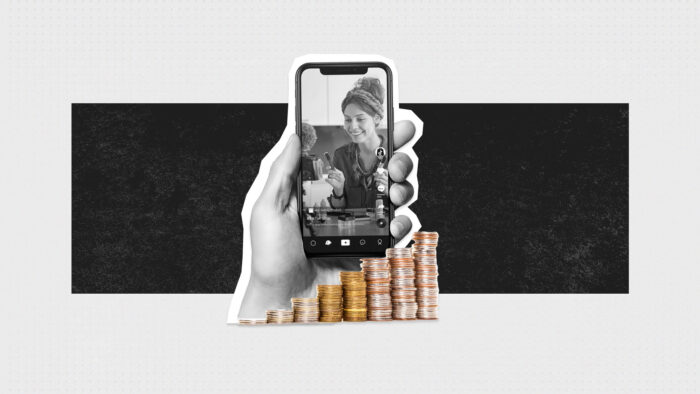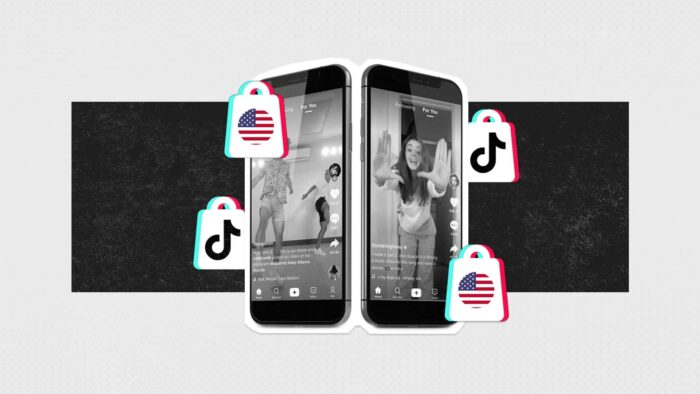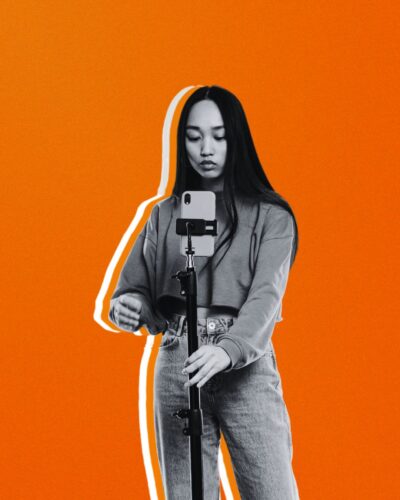In recent years, the landscape of commerce has undergone a transformative shift, where the lines between social media and shopping have blurred to create an engaging fusion known as social commerce. At the heart of this revolution are influencers, who have the power to shape consumer behavior and drive momentum on behalf of brands.
We’re delving into the synergy between influencer marketing and social commerce, exploring the rise of this dynamic duo, its impact on brands, and the exciting prospects it holds for the future of online shopping.

The Rise of Social Commerce
Social commerce, the amalgamation of social media and e-commerce, has seen monumental growth over the last few years. Fuelled by the fusion of tech innovation and evolving consumer habits, key social platforms have transformed into virtual shopping outlets. From Meta-owned Facebook and Instagram, to TikTok, and even Pinterest – each network has integrated in-app shopping experiences, product tagging, and clickable purchase links, all to streamline the buying process within their platforms. With approximately 5.25 billion people having access to a smartphone, it’s no surprise that this shift in consumption has come around. Mobile shopping is not only prevalent, but also exceedingly convenient, combine that with social (where everyone spends their time) and you strike the perfect balance. Social commerce in 2023 is enabling shoppers to browse, discover, and purchase products on demand.
How brands use social commerce
Social commerce remains largely untapped by brands, particularly in Western markets. The idea of shopping on social media was popularized in China, where platforms like Douyin (TikTok), WeChat, and more, have served as shopping hubs for several years. Despite its large success, social commerce had failed to make a sustainable splash in Europe, and the US, until recently.
Now, social commerce is starting to take full effect, we’re seeing brands leverage platforms in various ways to tap into its immense potential. Scrolling through Instagram or TikTok today, you might find shoppable posts and stories, or shopping tags integrated into branded content allowing for seamless product discovery and purchasing.
Live streaming has seen a renaissance of its own, with real-time events ganging popularity outside of platforms like Twitch and YouTube. Brands are utilizing live video features across TikTok, and Instagram, to host interactive shopping events. These events have enabled brands to showcase their products, engage with their target audience, and provide exclusive deals, all in real-time. This surge in live shippable content means that consumers can engage with brands and make purchases at the peak of their engagement, in the moments where brands have them hooked. Live formulas like TikTok Live, and Twitch Streams can convert consumers from consideration to confirming purchase within the same marketing activity by fostering a sense of exclusivity.
Brands also integrate user-generated content (UGC) with their social commerce strategies. Across TikTok, YouTube, Instagram, and practically any platform where users post content, you’ll see brands encouraging customers to share their experiences. Typically, we see people sharing their reviews, photos, videos, and testimonials, all of which provide an authentic insight to potential customers viewing that content. UGC serves as the social proof, helping to build trust in the brand and its offerings.
Influencer marketing powering social commerce
Offering perhaps the biggest boost to social commerce is influencer marketing. Brands are constantly upping their budgets to expand and diversify influencer strategies, which now includes powering social commerce campaigns.
Before we get into how influencers are powering social commerce, let’s dig into the latest development from the influencer/e-commerce space.
We are excited to bring to you an industry-first solution, developed by The Goat Agency in partnership with Amazon ads. We’ve combined the power of influencer marketing with the data and targeting of Amazon’s ad capabilities.
What does this mean?
We now have the capacity to retarget audiences that have already seen your brand’s influencer content on social platforms across Amazon’s retail media network on approved third party websites. For example, you might be reading an article in The Guardian (virtually of course), when an ad catches your eye. You recognize the influencer in the creative (that’s our part), and click through to find you’ve arrived at a featured product on Amazon – it’s as easy as that!
This enables brands to tap into Amazon’s vast advertising solutions, and is a huge step forward for combining influencer marketing and social commerce. Want the full picture? Learn more about our retail media and social commerce solution here.
Combining social commerce with influencer marketing is the new meta. D2C brands take note, here’s how influencers are powering the social commerce scene in 2023.
Enhanced trust and credibility
Influencers are seen as the pillars of modern society. While it’s perhaps not to that extreme, they do hold a significant influence over those that follow them. They’re looked to for advice, endorsements, and recommendations, which means consumers are more likely to trust them in comparison to other recognisable figures. This is why brands are partnering with influencers to launch social commerce campaigns. Whether that’s through an influencer-led email campaign featuring new product drops worn by creators, or sponsored posts on Instagram with tagged products that viewers can click-through to, having an influencer at the forefront of the activity is likely to heighten credibility.
Authentic, user generated content
When influencers encourage their followers to share their experiences with the promoted products, it often leads to authentic UGC. This is a valuable tool for brands, as it provides social proof and authentic testimonials from real customers. Influencer promotions can sometimes be viewed negatively by potential customers i.e. influencers are being paid to speak highly of a brand or product so how authentic is the endorsement. This is where UGC bridges the gap. Genuine consumers sharing their thoughts and opinions about a product, is why it’s such a powerful asset for brands’ influencer-led social commerce campaigns.
Multi-purpose content
Influencers can create and distribute content across various social media platforms, from TikTok and YouTube to Pinterest and Instagram. Having this diversification onside means that brands can reach a larger pool of potential customers, and adapt their content to suit the strengths of each platform. Diversifying content distribution also means that, as a brand, you get more bang for your buck. Say you activate an influencer for a shoppable live stream on YouTube, some of that content can be clipped up and shared across TikTok and Instagram, with tagged product links. Talk about efficiency.
Targeted marketing
Using influencers to power social commerce strategies means that you’re tapping into a hyper-engaged, loyal, ready-made audience. Are you a D2C brand looking to offload a new line of sneakers? Look no further than the army of sneaker heads on TikTok. In fact, #sneakers has just surpassed 70.3 billion views! Where there’s a niche, there’s a community, and we specialize in delivering niche content to niche communities… so hit us up.

Considerations for pairing influencer marketing and social commerce
Pick your influencers wisely (and build long-term relationships)
This will of course depend on your goals and long-term vision, but you should consider who you want to partner with, how they fit within your brand ethos, and how long for. Thinking long-term has a much more fruitful outcome. Brands who want to factor in consistency and build credibility should look to activate long-term partnerships. Having the same faces appear on brand channels, and brands featuring in the same influencers’ content helps to build a stronger connection with the desired audience. It goes without saying that long-term relationships with creators requires an ongoing commitment.
Ensure the social commerce purchase process is seamless
The beauty of social commerce is that it’s seamless. Online shoppers can discover a product and be ready to checkout within minutes with the variety of tools available today. Brands on TikTok can integrate a “Shop Now” button into influencer content which enables users to click straight through to the retailer website. Fashion retailers on Instagram frequently use the Stories feature to showcase their products, adding in a link click sticker that takes them directly to the product page. Gone are the days of “head over to our website”. Brands have the tools to make social commerce seamless, which is what audiences expect.
Content Guidelines and Creative Freedom:
Brand should consider clearly outlining all guidelines and expectations, but also allow influencers to have creative freedom. Brands can be guilty of briefing the creativity out of a campaign with stifling requirements and deadlines. While it is important to have guidelines, creators need to be able to do what they do best. After all, they are experts in engaging their audience, which is why you’re partnering with them in the first place.
Brands already successfully using influencers in their social commerce strategy
Wayfair
As we mentioned, social commerce in the West has only had a meaningful impact in the last year or so. When Wayfair approached us with the challenge of activating influencers to deliver a live commerce campaign, it was uncharted territory for both parties.
Wayfair wanted to explore live commerce, using influencers to lead the creative through engaging streams that displayed products in real time and influenced audiences towards purchase decisions.
We chose 12 influencers to host live streams around the brand’s top sales days, like Way Day, and even cooking lessons that displayed branded kitchenware. These live streams took place across Instagram and TikTok.
Like we’re always preaching, we ensured that each influencer was the right fit, and aligned perfectly with Wayfair’s vision and ethos. What’s more, we dedicated resources towards coaching the influencers on each product. This helped ensure each creator had a deeper connection to the products, but the brand too.
Superdrug
At the time of writing, it’s spooky season and things are getting eerie over on TikTok.
The British health and beauty retailer is bringing the scare factor with its 2023 Halloween social commerce campaign, powered by influencers. Partnering with popular beauty influencers, Superdrug is challenging creators to channel their inner doll using a range of beauty products available at Superdrug.
Through the different influencer channels, audiences are being inspired to create their own #DollAfterDark Halloween makeup, which is where they’re considering the featured products. Superdrug have also integrated a paid ads strategy, retargeting those who have watched the influencer ads. These video ads prompt viewers with TikTok’s Shop Now feature, taking potential customers directly to the retailer website where they’re driven to purchase. Superdrug is using the widespread reach that influencers have to raise awareness for their products, hooking them with engaging, seasonal-themed content, and retargeting viewers of the influencer content with shoppable video ads driving them to purchase.
The future of Influencer marketing and social commerce- concluding thoughts
The future of influencer-led social commerce is poised for continued growth and innovation. With tech continually advancing, the integration of things like AI ,and analytics tools, will start to take more of a significant effect. These offerings should enable brands to further optimize and innovate within the influencer social commerce space, resulting in more precise and efficient influencer marketing initiatives.
Social platforms show no sign of slowing their commerce capacities, too. Will we see even more avenues for shoppers to indulge on social media. Expect in-app purchasing and instant checkout to enhance the convenience of online shopping directly from influencers’ content, reducing the friction of the buying journey. We’re already at seamless, what’s smoother than that? How much more simplified can the process get?
Brands that can navigate this dynamic landscape while keeping a tight grip on their goals and ethos will be well-positioned for success.
—
Are you a brand looking to explore influencer-led social commerce? Goat is the first influencer marketing agency to bridge the gap between influencer marketing and retail media, creating a powerful commerce-led solution. Get in touch to find out how we can help you!





